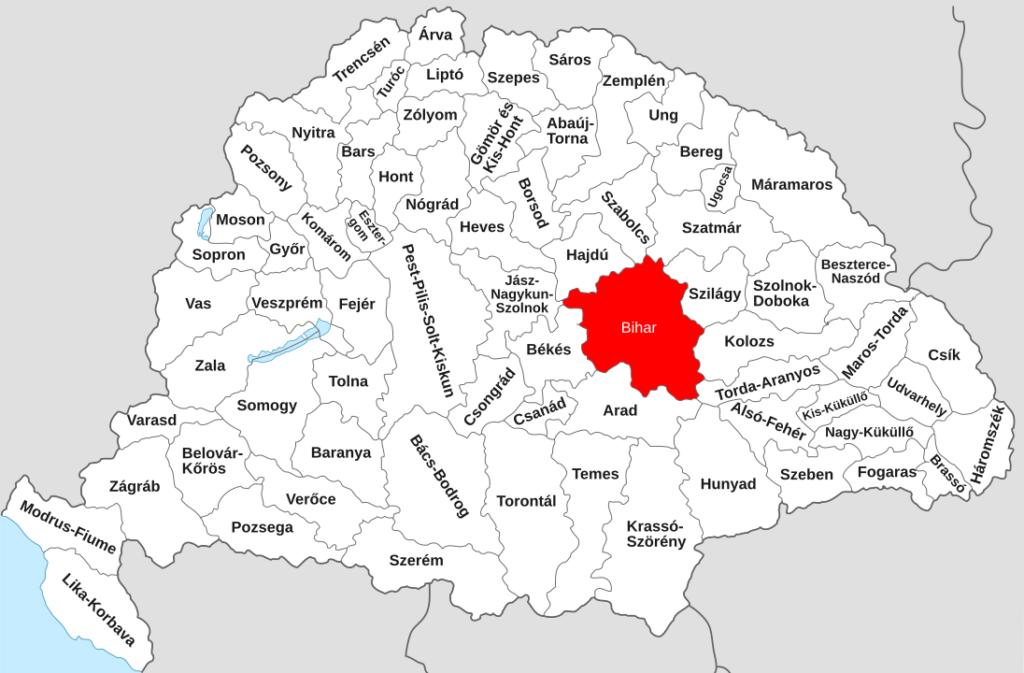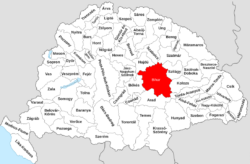
Bihar (Romanian: Biharia) is a municipality in Bihar (Bihor) County, Romania. It is situated 12 km north of the city of Nagyvárad (Oradea), on the right bank of the Kösmő stream. It is the namesake and the first center of Bihar County in the Kingdom of Hungary. The Bihar earthwork castle is one of the most spectacular and best preserved Árpád-era earthwork castles in the Carpathian Basin. In 1910, 3021 of its 3027 inhabitants were Hungarian. Until the Treaty of Trianon, it was part of the Nagyvárad district of Bihar County.

The Bihar earth castle, also known as Biharvár and its surroundings, may have been an important princely center between the Great Plain and Transylvania during the Hungarian conquest. The whole area of Bihar is characterized by the abundance of Hungarian horse graves dating from the time of the Hungarian occupation. Location: https://tinyurl.com/4y8npsyp

Bihar Castle was, according to the story of Anonymus, the center of the Khazar country, the castle of Ménmarót, their chief.
In the Gesta Hungarorum of the early 13th century, Anonymus mentioned the castle of Bihar:
“A few days later, on the advice of his nobles, the leader Árpád sent envoys to the castle of Bihar to the leader Mén-Marót and asked him to cede to him the land stretching from the river Szamos to the border of Nyir and the gate of Meszes from what belonged to his forefather, King Attila. … But Maroth the leader left his many soldiers in the castle of Bihar, and he, fleeing from them with his wife and daughter, made his dwelling in the thickets of Igyfon.
Ösbő and Velek and their whole army set off against the castle of Bihar and camped by the waters of the Jószás. On the third day, they formed their armies, marched toward the castle, and fought. But also the soldiers of the different nations who had gathered began to fight against Ösbő and his soldiers. The Székelys and the Hungarians had killed many men with their bows and arrows.
Ösbő and Velek killed one hundred and twenty-five soldiers with their throwing machines. The battle went on for twelve days, and among Ösbő’s soldiers, twenty Hungarians and fifteen Székelys fell. And on the thirteenth day, when the Hungarians and the Székelys had filled up the moats of the castle, and were about to lean the battlements against the wall, the soldiers of the chief Mén-Marót, seeing the daring of the Hungarians, began to plead with the two captains of the army, and then, opening the castle, came barefoot and begging before Ösbő and Velek. They were taken into custody by Ösbő and Velek, and they entered the castle of Bihar, and found there many precious things belonging to those soldiers.”

The Bihor castle is one of the four largest of its kind, together with Szabolcs, Zemplén, and Abaújvár. According to archaeological research, a small U-shaped Leányvár was a Bronze Age entrenched castle, part of which was later built over by the Bihar timber-framed castle.
Even in the 20th century, Biharvár was surrounded by earthen walls 9-12 meters high and almost 15 meters wide, which together with the fortifications covered an area of 8 hectares (200×182 meters).

The date of the construction of the large Bihar earthwork is uncertain, and scholars have different opinions. Bihar was built in the 10th century at the earliest, perhaps as a castle of Árpád’s son Zolta mentioned in the Gesta of Anonymus, or because of the realistic threat of the Pechenegs.
A 10th-century layer was found during the excavation of the castle, and 10th-century burials were discovered on the hill opposite the castle, which may be the graves of the first guards of the castle, but their connection with the ramparts is not clear. What can be said, however, is that the castle of Menmarót mentioned in Anonymus’ Gesta did not exist, and there are no archaeological traces of it. The vast majority of scholars think that the castle of Bihar dates from the early 11th century. The Bihar castle became the center of the newly established Bihar County.

The castle was also the seat of the bishopric of Bihar, which was once thought to have been founded by St Stephen, but more recent research confirms that it was founded by King András I. The first mention of its bishop dates back to 1067 (Leodvin). The bishopric was later transferred to Várad by King Saint László. During the excavation of the castle, it became clear that the castle originally had one gate, the south-western one, the north and south-eastern corners of the rampart, was opened by the Kuruc troops camped there at the beginning of the Rákóczi War of Independence.
The castle of Bihar was the center of the early Árpád princes’ dukedom, the seat of the younger brother of King András I, later King Béla I, with independent minting rights. The clash for the crown between Prince András and Prince Béla took place east of the Tisza River, in or near Béla’s duchy of Bihar, where Béla was victorious. After the death of Béla I (1064), King Salamon I, son of King András I, became king. The Dukedom of Bihar was given to Béla’s sons, Princes Géza, László and Lampert.
In 1068, led by Osul the chieftain, the Pechenegs or Uz (sources are unclear) invaded the country through the Meszes Gate. They plundered as far as the castle of Bihar when the castle itself was badly damaged. King Salamon, together with princes Géza and László, crushed them in the Battle of Kerlés.

In 1074, at the Battle of Mogyoród, the troops of the Duchy of Bihar and Nyitra took part on the side of Princes Géza and László. (“Bihoriensi agmine, Nitriensi agmine”).
Bihar was next attacked during the reign of King Saint László in 1091. According to the Chronicle Pictum, the army of the Cumans “crossed the land of Transylvania, ravaging it, and went to Byhor.” At this time, the country was invaded by the Cumans under their leader named Kopulcs (“Cunis nomine Copulch”). The castle was also damaged in the fighting.

The ramparts were made higher after the destruction of 1091, and in the 12th century, a stone wall about 3 meters wide was built on top of the ramparts. During the reign of King Kálmán the Bookish, Prince Álmos was the lord of the Duchy of Bihar, but because of his repeated rebellions against the king, Kálmán abolished the duchy in 1107.

A charter of King Imre in 1198 confirmed the church of Nagyvárad in the possession of the customs on the Körös river belonging to the castle of Bihar, which had been granted to the bishopric by King Saint László “trib. castri Bychor, de Kewres… ” The castle is also special because it was here that King Saint László spent part of his childhood, and as lord of the duchy, he was also able to spend much of his time in the area.

After the Mongol invasion, documents about the bishopric of Bihar are very rare. Zsoldos Attila suggests that “…the suspicion therefore arises that the Bihar Castle County, whose territory was particularly devastated by the Tatars, suffered such heavy blood losses in the disaster of 1241/42 that it may not have survived into the second half of the 13th century.”

In 1268, King Stephen the Younger released Chaz’s sons, Chak, Péter, Jakab, and Benedek from their serfdom in the manor of Bihar Castle and accepted them as royal servants.
Borovszky Samu states, “The settlement of Bihar was recorded in 1349 as Byhor and a charter of 1374 mentioned its right to hold a fair. In 1393 it was listed as Villa Byhor, and in 1470 as Oppidum Byhar, and at that time its inhabitants included several craftsmen. In the census of 1520, it was mentioned as a tax-collecting place. In the 15th century, it was an archdiocese, and in the 16th century a subdiocese, with 18 parishes. The former size of the parish is best attested by the tax censuses of the 16th century when 176 families lived in Bihar. Its present Reformed church was built in 1802 on the foundations of the ancient church, which dates back to the 14th century.”

In 1703, 10 infantry and 5 cavalry companies led by Colonel Jármy Ferenc camped in the entrenchments of the long-abandoned Bihar castle as part of the Kuruc siege barrier surrounding the castle of Nagyvárad. The imperial troops, moving from Arad and Szeged, broke the siege of Nagyvárad and supplied it with food. The Kuruc captains of Bihar were informed of the Imperial movements and Jármy had the old entrenchments of the castle reinforced. However, at dawn on 7 January 1704, Colonel Georg Wilhelm Löffelholz’s troops ambushed them and were completely crushed. The Kuruc suffered very heavy losses, Jármy himself and his officers fell, and the Imperials had perhaps 20 dead and around 50 wounded.

To commemorate the Millennium, a monument with a Turul Bird was erected on a mound of earth in the castle in 1896. The Romanians removed it after 1918, and a flagpole now stands in its place.
On the west side of the monument was the following inscription:
“In commemoration of the millennial entry of the Hungarians, erected from public donations, with the support of Bihar County, 1896.”
On the northern side:
“Stand stone monument, stand forever! As a symbol of patriotism. Teach all the sons of this nation to love the Homeland until the end of their lives.”
On the southern side:
“O God of Hungarians, hear our prayer, Make our beloved homeland great and happy. Protect us from the enemy, Protect us from inward strife, That we may be admired and envied by the world.”
On the eastern side:
“This castle in Bihar, conquered by our glorious ancestors from the Bulgarian prince Mén Maróth, was the castle of Hungarian freedom many centuries ago, the home of Rákóczy’s Kuruc soldiers and the scene of his bloody battles.”

In 1992 the settlement of Bihar had 5668 inhabitants, of which 5082 were Hungarians, 555 Romanians, 20 Gypsies and 3 Germans. In 2011, the population of 4205 inhabitants was 3448 Hungarians, 611 Romanians, 11 Gypsies and 4 Slovaks.
If you want to visit a great market, you can do it each year on 8-9 September when a special fair is organized inside the walls. According to news from 2022, the castle would be renewed with the help of European Union funds. More than €2.5 million will be spent to renovate the castle. The impact assessment was carried out with special attention to the historic character of the castle. In the inner courtyard, a lightweight reconstruction of a medieval village hall will be created, which will provide an interactive experience of the daily life of the people of the time.

At the same time, a 250 square meter tourist information center will be built outside. As part of the St. László Way, the St. László Abbey, founded by St. László in 1083, and the Bihar Castle are being renovated for €2.25 million. (2022)
Dear Readers, I can only make this content available through small donations or by selling my books or T-shirts:
Please, support me with a coffee here: https://www.buymeacoffee.com/duhoxoxa
You can check out my books on Amazon or Draft2Digital, they are available in hardcover, paperback, or ebook:
https://www.amazon.com/dp/198020490X or at https://books2read.com/b/boYd81

My work can also be followed and supported on Patreon: Become a Patron!http://Become a Patron!
Become a Patron! and donations can be sent by PayPal, too: https://tinyurl.com/yknsvbk7


https://hungarianottomanwars.myspreadshop.com/all
Subscribe to my newsletter here: https://tinyurl.com/4jdjbfkn
Here are a few pictures of Bihar Castle:





















